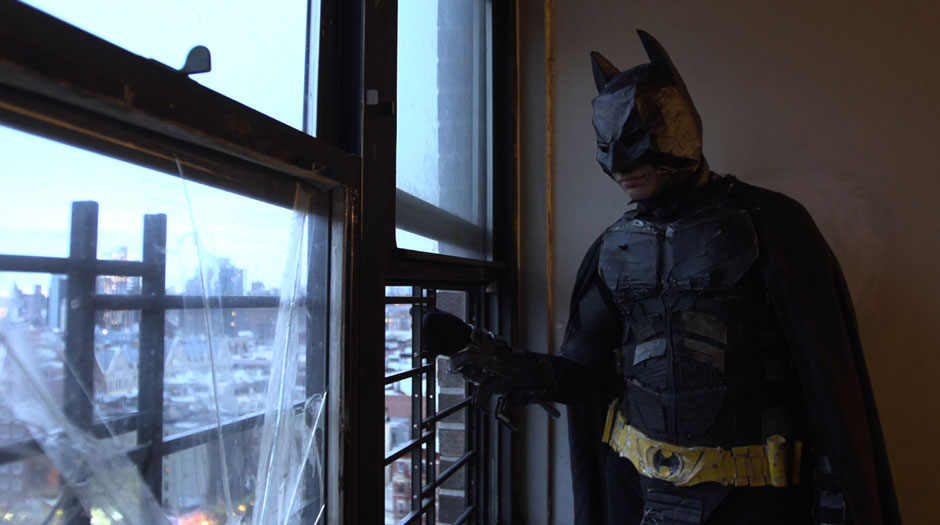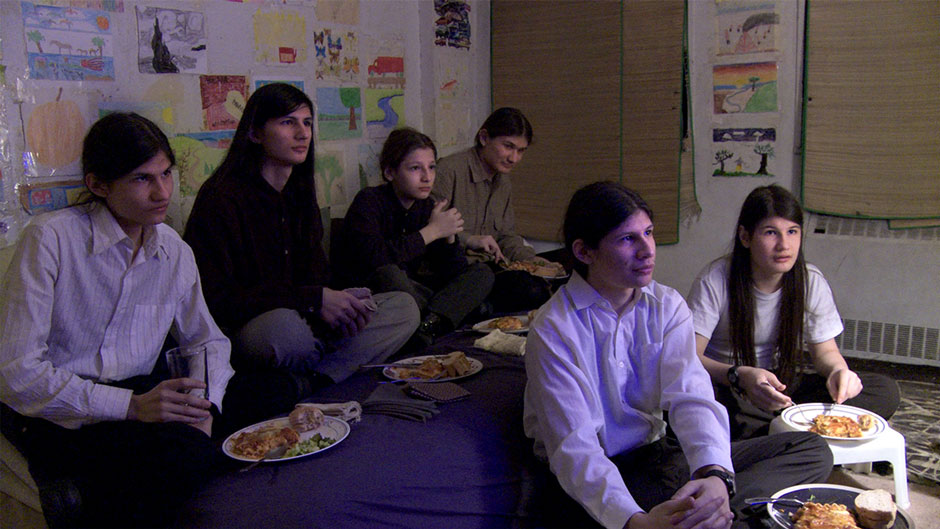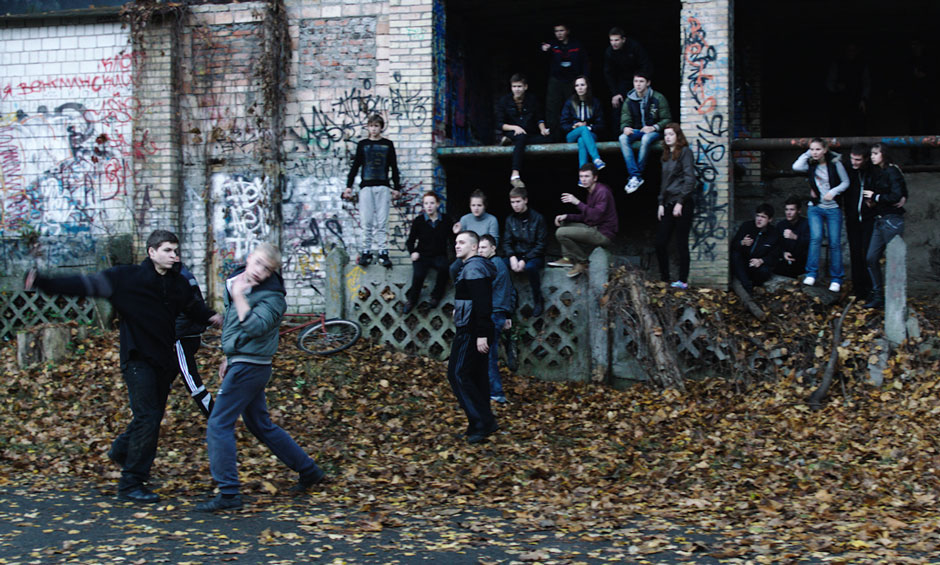Though they are set at opposite ends of the earth and represent opposed forms of cinema, The Wolfpack and The Tribe have much in common. Both new films share a concern with male-dominated groups vying for power inside what Nietzsche called “the prison house of language”; they also have interchangeable titles that might be more appropriate if they were flipped.
A documentary made by American filmmaker Crystal Moselle, The Wolfpack concerns a large family that, self-isolated for years in a New York City housing project, developed its own tribal culture largely based on Hollywood blockbusters. The Tribe, a first feature by Ukrainian director Myroslav Slaboshpytskiy, is a fiction film set mainly within the dog-eat-dog confines of a Kiev boarding school for hearing-impaired adolescents and played out entirely in sign language by amateur, similarly impaired actors.
Both movies were greeted with acclaim at important film festivals. The Tribe won the top prize in Cannes’s “Critics Week” section in 2014; The Wolfpack was awarded the grand jury prize for documentary earlier this year at Sundance. While either work might be described as a human interest story, with a good measure of tabloid sensationalism, neither seems likely to elicit the same enthusiasm in a general audience (although The Wolfpack does at least have a happy ending). It’s the novel use of the motion picture medium, inviting a double consciousness—which is to say, a critical awareness of how they were made—that makes both films of particular interest to filmmakers and professional movie-goers.
As one of Moselle’s subjects explains, “the movies helped us create our own kind of world.” The filmmaker herself got the break of a lifetime when she came upon the six look-alike Angulo brothers striding through the East Village, long hair streaming down their backs, all wearing sun-glasses and dressed in outfits clearly inspired by the criminal band in Quentin Tarantino’s Reservoir Dogs. It was as though, on one of this self-named Wolfpack’s first forays together into the outside world, they were hoping to be discovered—and they were.
Raised almost entirely within the confines of the family apartment, high above Delancey Street, the brothers—then in their late teens and early twenties—and a single, mentally handicapped sister, had been forbidden by their paranoid and most likely abusive father Oscar Angulo to venture alone into the world. (Oscar was afraid of contamination. In a way he was performing a version of the experiment reported by Herodotus where, in order to ascertain whether language was innate, an Egyptian pharaoh had two children brought up without ever hearing human speech.) In the absence of conventional socialization, the boys, all given Sanskrit names, came to know the world through rented DVDs, Oscar’s Peruvian version of Hare Krishna Hinduism, and the home-schooling provided by their mother Susanne, a Midwestern hippie.
Moselle met the Wolfpack soon after they had broken free of Oscar’s regime but the first half of her film, which was made over a period of four years, is devoted to reconstructing the family’s isolation, as explained by the Angulos—who are not nearly as feral as their upbringing might suggest. The family apartment may be cluttered but it isn’t squalid or depressing; the walls are covered with crayon sketches and other evidence of the creativity within. The first scene has one of the Angulo boys is transcribing the dialogue from Tarantino’s Pulp Fiction. “It makes me feel like I’m living, sort of,” he laughs; later we see part of a VHS tape of their version of The Dark Knight, complete with homemade costumes.
Mukunda Angulo, the Wolfpack’s apparent leader, describes his first solo voyage from the apartment, wandering the streets and visiting a bodega wearing a mask modeled after the one worn by the monster in Halloween. Unsurprisingly, he was soon apprehended by the police and taken to Bellevue. The cops subsequently raided the Angulo apartment, where they were surprised to find only prop weapons. This is all in the past. The boys, many of whom have taken new names, are surprisingly and increasingly “normal” as Moselle films them at the beach, visiting an apple orchard, and, most significantly, making their first trip to a movie theater. Oscar, for his part, seems to have retreated into an alcoholic stupor.
The Tribe is the opposite of an escape story, except in so far as the filmmaker has succeeded in liberating cinema from the tyranny of the spoken word. Slaboshpytskiy’s unsettling feature concerns a new student (or inmate)—around 16 years old—who falls in with the school’s ruling criminal clique. The movie is leisurely as well as graphic in its representation of sex and violence and, predicated on long takes, is visceral in a wholly unexpected way.
Advertisement
Observing the deaf without approximating their experience, The Tribe has no subtitles; it’s only fully comprehensible to someone familiar with Russian sign language. At the same time, the sounds that the characters cannot hear take on a heightened presence. Speech isn’t made material—it is material, always on the verge of physical contact and punctuated by percussive slaps that alert us when the characters are “yelling.”
Like Werner Herzog’s 1971 documentary Land of Silence and Darkness, The Tribe unfolds in an alternative universe. By the time the protagonist has his first class, the audience has become hypersensitive to sound, attentive to the forms of silent disruption and mockery practiced by the students. We never see the inside of a classroom again; the new boy’s lessons are, as it were, learned on the street. Two female students change into hooker outfits and are driven off in a van to be pimped to truckers. The protagonist subsequently becomes involved with one of them, with appalling results.
The Wolfpack frustrates the viewer’s expectations as well. I certainly would have liked to see more of the Angulo family’s homemade films and Moselle leaves unexplored numerous questions regarding Oscar’s philosophy and his manner of enforcing discipline. Even more mysterious is the method Oscar and Susanne used to game the system (something all too clear in The Tribe). Getting what appears to be a four-bedroom apartment in public housing is no small accomplishment, especially since Oscar claims to be opposed on principal to holding a job. The Angulo family finances are similarly enigmatic—the explanation that Susanne was paid to oversee her brood’s home schooling is tantalizingly incomplete.
These questions are subsumed in The Wolfpack’s stunning testament to the redemptive power of cinema. Just as the Angulo boys saved themselves through the production of elaborate home movies, the filmmaker’s intervention is shown as entirely beneficial, not least when she documents Susanne telephoning her mother for the first time in fifty (!) years: “I have seven children!” she excitedly reveals. Finally, newly inspired by the documentary in which they appear, the Angulo boys are shown producing a new movie, featuring an attractive young woman, perhaps to be premiered at next year’s Sundance Film Festival.
Where The Wolfpack celebrates cinema as we know it, The Tribe dismantles it. Slaboshpytskiy has called the film his “homage to silent movies.” The Tribe is as predicated on movement as a ballet—every conversation precipitates a flurry of expressive facial and hand gestures. It can be a bludgeoning experience, yet to watch it is to ponder the primacy of visual experience and its presumed universality.
In their way, The Wolfpack and The Tribe represent the classic Lumière/Méliès dichotomy—do motion pictures reflect or construct reality? The opposition has existed since the medium was invented. But here there is a twist. The Wolfpack is a documentary that delights the viewer with proliferating fictions. The Tribe, more brutal, is an invented story founded on a discomfiting bedrock of documentary truth.
The Wolfpack and The Tribe are now playing at select theaters.





